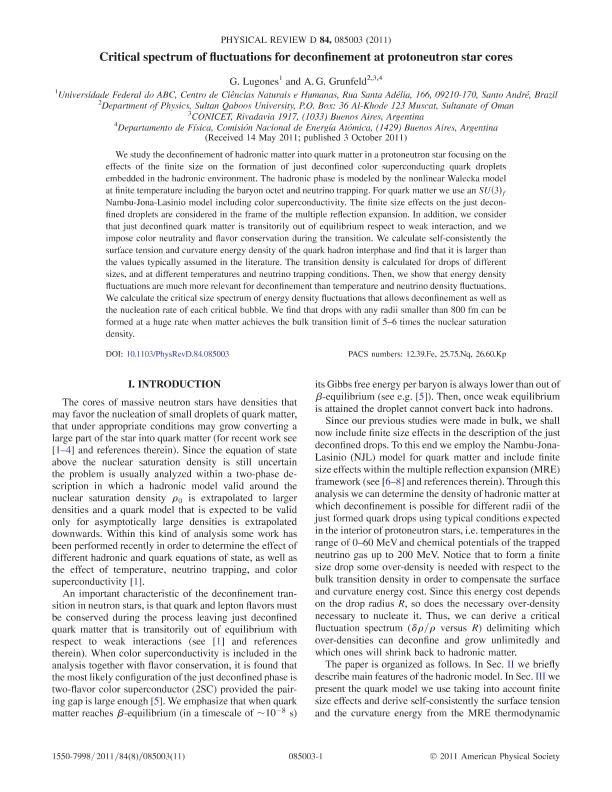Mostrar el registro sencillo del ítem
dc.contributor.author
Lugones, G.
dc.contributor.author
Grunfeld, Ana Gabriela

dc.date.available
2023-02-27T10:57:42Z
dc.date.issued
2011-10
dc.identifier.citation
Lugones, G.; Grunfeld, Ana Gabriela; Critical spectrum of fluctuations for deconfinement at protoneutron star cores; American Physical Society; Physical Review D: Particles, Fields, Gravitation and Cosmology; 84; 8; 10-2011; 1-11
dc.identifier.issn
1550-7998
dc.identifier.uri
http://hdl.handle.net/11336/188905
dc.description.abstract
We study the deconfinement of hadronic matter into quark matter in a protoneutron star focusing on the effects of the finite size on the formation of just deconfined color superconducting quark droplets embedded in the hadronic environment. The hadronic phase is modeled by the nonlinear Walecka model at finite temperature including the baryon octet and neutrino trapping. For quark matter we use an SU(3)f Nambu-Jona-Lasinio model including color superconductivity. The finite size effects on the just deconfined droplets are considered in the frame of the multiple reflection expansion. In addition, we consider that just deconfined quark matter is transitorily out of equilibrium respect to weak interaction, and we impose color neutrality and flavor conservation during the transition. We calculate self-consistently the surface tension and curvature energy density of the quark hadron interphase and find that it is larger than the values typically assumed in the literature. The transition density is calculated for drops of different sizes, and at different temperatures and neutrino trapping conditions. Then, we show that energy density fluctuations are much more relevant for deconfinement than temperature and neutrino density fluctuations. We calculate the critical size spectrum of energy density fluctuations that allows deconfinement as well as the nucleation rate of each critical bubble. We find that drops with any radii smaller than 800fm can be formed at a huge rate when matter achieves the bulk transition limit of 5-6 times the nuclear saturation density.
dc.format
application/pdf
dc.language.iso
eng
dc.publisher
American Physical Society

dc.rights
info:eu-repo/semantics/openAccess
dc.rights.uri
https://creativecommons.org/licenses/by-nc-sa/2.5/ar/
dc.subject
Chiral Lagrangians
dc.subject
Quark deconfinement
dc.subject
Equations of state of neutron-star matter
dc.subject.classification
Física de Partículas y Campos

dc.subject.classification
Ciencias Físicas

dc.subject.classification
CIENCIAS NATURALES Y EXACTAS

dc.title
Critical spectrum of fluctuations for deconfinement at protoneutron star cores
dc.type
info:eu-repo/semantics/article
dc.type
info:ar-repo/semantics/artículo
dc.type
info:eu-repo/semantics/publishedVersion
dc.date.updated
2023-02-26T15:30:44Z
dc.journal.volume
84
dc.journal.number
8
dc.journal.pagination
1-11
dc.journal.pais
Estados Unidos

dc.description.fil
Fil: Lugones, G.. Universidad Federal do Abc; Brasil
dc.description.fil
Fil: Grunfeld, Ana Gabriela. Consejo Nacional de Investigaciones Científicas y Técnicas; Argentina. Comisión Nacional de Energía Atómica. Gerencia del Área de Investigaciones y Aplicaciones no Nucleares. Gerencia de Física (Centro Atómico Constituyentes); Argentina
dc.journal.title
Physical Review D: Particles, Fields, Gravitation and Cosmology

dc.relation.alternativeid
info:eu-repo/semantics/altIdentifier/url/http://prd.aps.org/abstract/PRD/v84/i8/e085003
dc.relation.alternativeid
info:eu-repo/semantics/altIdentifier/doi/http://dx.doi.org/10.1103/PhysRevD.84.085003
Archivos asociados
